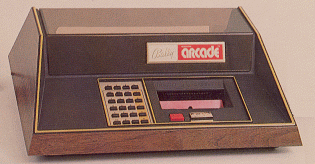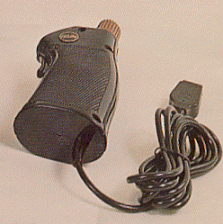| |
|
|
SYSTEM
The back of the unit has a black shield which lifts out to reveal a slotted storage space, perfect for storing your controllers, cartridges, or a few of each. Below the storage space is a keypad with a generous twenty four buttons, as well as a horizontally oriented cartridge slot and two additional buttons. These buttons eject the cartridges and reset the system. CARTRIDGES Perhaps the reason less experienced gamers had such a nasty habit of referring to cartridges as "tapes" was because Bally made it tough to distinguish between the two forms of media. Games on the Astrocade are referred to as "cassetridges" and are approximately the same size and thickness as an audio cassette. They even have notches on one end... these are used to hold the cartridge in place after it's inserted into the system. While we're on the subject, now would be a good time to discuss the Astrocade's cartridge slot. It's unique in that the cartridges are inserted horizontally and pressed down to lock them into place. It's a bit like the Nintendo Entertainment System, except the carts remain visible and the game is much more likely to, you know, work. Another unique twist is that the cartridges can be inserted and removed while the system is on. It's anyone's guess as to why you'd want to do this, but it is an option... just hit the reset button afterwards to refresh the system and you're in business. JOYSTICK
INTERFACE It's easy to set up the Astrocade... just hook it up to your television set, plug the AC adapter into the nearest wall, and insert a cartridge. You don't even need to put in a cart... the Astrocade has two games and two utilities built into it. When you turn on the system, you're met with an options screen, perhaps one of the most verbose and user-friendly ones I've seen in an older game system. For once, the games and options are described adequately, so there's never any guesswork involved in getting started. Your options are selected by either the keypad built into the unit or, in a welcome twist, the controller itself. Just press the trigger, twist the knob to dial in your selection, then press the trigger again to confirm your choice. GAMES AND HARDWARE
OVERALL The Astrocade may have been impressive back when it was first released, but these days, it finds itself on awkward middle ground. It's more powerful and flexible than the Odyssey2, yet not nearly as well supported as the 2600 or Intellivision. I guess your interest in the Astrocade would depend largely on your appreciation for innovation and a love for Bally and its products. The system has a lot of unique and very useful features; qualities that are sorely lacking in other consoles. To top it all off, it's by Bally, which makes it a nice conversation piece... provided that everyone in the conversation actually remembers that Bally used to make video games. |
|
 The Astrocade has
an attractive trapezoidal shape... not exactly streamlined in
comparison to some of the newer systems, but nevertheless
effectively designed. My console was off-white with gold trim,
but it's my understanding that most Astrocade systems are
decorated with woodgrain. This was a popular decorative style
in the 70's, and you may have noticed it used in other game systems,
particularly the Atari 2600.
The Astrocade has
an attractive trapezoidal shape... not exactly streamlined in
comparison to some of the newer systems, but nevertheless
effectively designed. My console was off-white with gold trim,
but it's my understanding that most Astrocade systems are
decorated with woodgrain. This was a popular decorative style
in the 70's, and you may have noticed it used in other game systems,
particularly the Atari 2600. The controllers
are very stylish... my brother remarked that they look just like
pistol handles. Needless to say, they won't be making a
comeback on a modern day game system. The contoured handle and
textured sides feel pretty comfortable, but the downside is that the
design limits the player to just one action button. To
compensate, the small joystick on the top of the controller can be
twisted like a dial, giving the player simultaneous digital and
analog control. The designers took advantage of this feature
whenever they could... although arcade conversions like Space
Invaders and Galaxian just used the joystick and trigger, other
titles incorporated the dial as well. For instance, you use
the dial to aim your quarterback's throwing arm in the Astrocade
version of Football.
The controllers
are very stylish... my brother remarked that they look just like
pistol handles. Needless to say, they won't be making a
comeback on a modern day game system. The contoured handle and
textured sides feel pretty comfortable, but the downside is that the
design limits the player to just one action button. To
compensate, the small joystick on the top of the controller can be
twisted like a dial, giving the player simultaneous digital and
analog control. The designers took advantage of this feature
whenever they could... although arcade conversions like Space
Invaders and Galaxian just used the joystick and trigger, other
titles incorporated the dial as well. For instance, you use
the dial to aim your quarterback's throwing arm in the Astrocade
version of Football. Judging from what
I've played so far, the Astrocade is a step below the 2600 and
Intellivision in regards to overall game quality. Sure, the
Astrocade's games are more detailed and colorful than the earliest
2600 titles, but in comparison to Atari's later releases, Bally's
games come up short. One of the system's greatest flaws is
its extremely low resolution, which hurts the appeal of many of
its games. Just take a look at the otherwise excellent
Astrocade version of Wizard of Wor... it plays great and it sounds
great, but it sure ain't pretty. Fortunately, the limited
resolution is offset by multicolored characters and an arcade
quality sound chip. It's been said that the Astrocade uses
arcade hardware, in much the same way that the Dreamcast was
introduced to arcades as the Naomi. You wouldn't know this by
looking at the system's graphics, but the high quality audio is a
definite indication of the Astrocade's arcade roots.
Judging from what
I've played so far, the Astrocade is a step below the 2600 and
Intellivision in regards to overall game quality. Sure, the
Astrocade's games are more detailed and colorful than the earliest
2600 titles, but in comparison to Atari's later releases, Bally's
games come up short. One of the system's greatest flaws is
its extremely low resolution, which hurts the appeal of many of
its games. Just take a look at the otherwise excellent
Astrocade version of Wizard of Wor... it plays great and it sounds
great, but it sure ain't pretty. Fortunately, the limited
resolution is offset by multicolored characters and an arcade
quality sound chip. It's been said that the Astrocade uses
arcade hardware, in much the same way that the Dreamcast was
introduced to arcades as the Naomi. You wouldn't know this by
looking at the system's graphics, but the high quality audio is a
definite indication of the Astrocade's arcade roots.